child restraint CADILLAC ESCALADE 2020 Owner's Manual
[x] Cancel search | Manufacturer: CADILLAC, Model Year: 2020, Model line: ESCALADE, Model: CADILLAC ESCALADE 2020Pages: 392, PDF Size: 6.39 MB
Page 4 of 392
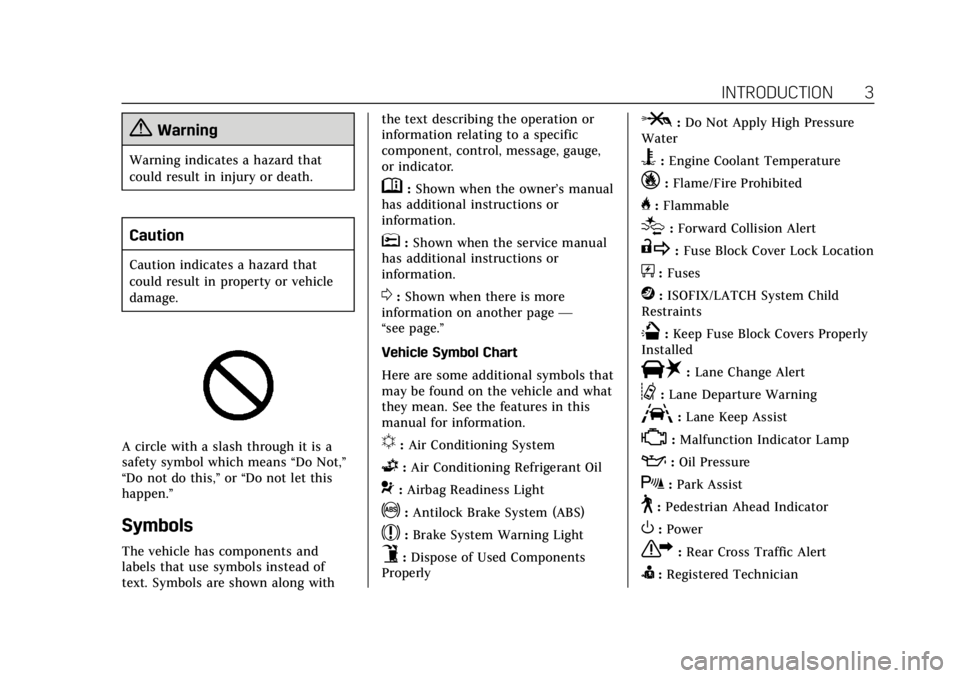
Cadillac Escalade Owner Manual (GMNA-Localizing-U.S./Canada/Mexico-
13566588) - 2020 - CRC - 4/24/19
INTRODUCTION 3
{Warning
Warning indicates a hazard that
could result in injury or death.
Caution
Caution indicates a hazard that
could result in property or vehicle
damage.
A circle with a slash through it is a
safety symbol which means“Do Not,”
“Do not do this,” or“Do not let this
happen.”
Symbols
The vehicle has components and
labels that use symbols instead of
text. Symbols are shown along with the text describing the operation or
information relating to a specific
component, control, message, gauge,
or indicator.
M:
Shown when the owner’s manual
has additional instructions or
information.
*: Shown when the service manual
has additional instructions or
information.
0: Shown when there is more
information on another page —
“see page.”
Vehicle Symbol Chart
Here are some additional symbols that
may be found on the vehicle and what
they mean. See the features in this
manual for information.
u: Air Conditioning System
G:Air Conditioning Refrigerant Oil
9:Airbag Readiness Light
!:Antilock Brake System (ABS)
$:Brake System Warning Light
9:Dispose of Used Components
Properly
P: Do Not Apply High Pressure
Water
B: Engine Coolant Temperature
_:Flame/Fire Prohibited
H: Flammable
[:Forward Collision Alert
R: Fuse Block Cover Lock Location
+:Fuses
j:ISOFIX/LATCH System Child
Restraints
Q: Keep Fuse Block Covers Properly
Installed
|: Lane Change Alert
@:Lane Departure Warning
A:Lane Keep Assist
*:Malfunction Indicator Lamp
::Oil Pressure
X:Park Assist
~:Pedestrian Ahead Indicator
O:Power
7: Rear Cross Traffic Alert
I:Registered Technician
Page 41 of 392
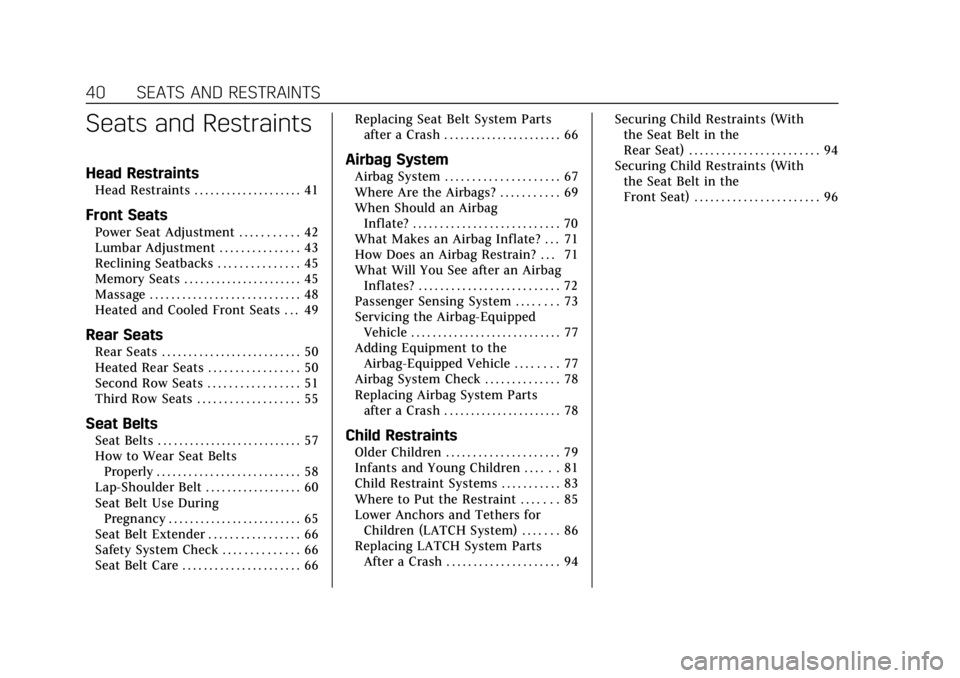
Cadillac Escalade Owner Manual (GMNA-Localizing-U.S./Canada/Mexico-
13566588) - 2020 - CRC - 4/24/19
40 SEATS AND RESTRAINTS
Seats and Restraints
Head Restraints
Head Restraints . . . . . . . . . . . . . . . . . . . . 41
Front Seats
Power Seat Adjustment . . . . . . . . . . . 42
Lumbar Adjustment . . . . . . . . . . . . . . . 43
Reclining Seatbacks . . . . . . . . . . . . . . . 45
Memory Seats . . . . . . . . . . . . . . . . . . . . . . 45
Massage . . . . . . . . . . . . . . . . . . . . . . . . . . . . 48
Heated and Cooled Front Seats . . . 49
Rear Seats
Rear Seats . . . . . . . . . . . . . . . . . . . . . . . . . . 50
Heated Rear Seats . . . . . . . . . . . . . . . . . 50
Second Row Seats . . . . . . . . . . . . . . . . . 51
Third Row Seats . . . . . . . . . . . . . . . . . . . 55
Seat Belts
Seat Belts . . . . . . . . . . . . . . . . . . . . . . . . . . . 57
How to Wear Seat BeltsProperly . . . . . . . . . . . . . . . . . . . . . . . . . . . 58
Lap-Shoulder Belt . . . . . . . . . . . . . . . . . . 60
Seat Belt Use During Pregnancy . . . . . . . . . . . . . . . . . . . . . . . . . 65
Seat Belt Extender . . . . . . . . . . . . . . . . . 66
Safety System Check . . . . . . . . . . . . . . 66
Seat Belt Care . . . . . . . . . . . . . . . . . . . . . . 66 Replacing Seat Belt System Parts
after a Crash . . . . . . . . . . . . . . . . . . . . . . 66
Airbag System
Airbag System . . . . . . . . . . . . . . . . . . . . . 67
Where Are the Airbags? . . . . . . . . . . . 69
When Should an AirbagInflate? . . . . . . . . . . . . . . . . . . . . . . . . . . . 70
What Makes an Airbag Inflate? . . . 71
How Does an Airbag Restrain? . . . 71
What Will You See after an Airbag Inflates? . . . . . . . . . . . . . . . . . . . . . . . . . . 72
Passenger Sensing System . . . . . . . . 73
Servicing the Airbag-Equipped Vehicle . . . . . . . . . . . . . . . . . . . . . . . . . . . . 77
Adding Equipment to the Airbag-Equipped Vehicle . . . . . . . . 77
Airbag System Check . . . . . . . . . . . . . . 78
Replacing Airbag System Parts after a Crash . . . . . . . . . . . . . . . . . . . . . . 78
Child Restraints
Older Children . . . . . . . . . . . . . . . . . . . . . 79
Infants and Young Children . . . . . . 81
Child Restraint Systems . . . . . . . . . . . 83
Where to Put the Restraint . . . . . . . 85
Lower Anchors and Tethers forChildren (LATCH System) . . . . . . . 86
Replacing LATCH System Parts
After a Crash . . . . . . . . . . . . . . . . . . . . . 94 Securing Child Restraints (With
the Seat Belt in the
Rear Seat) . . . . . . . . . . . . . . . . . . . . . . . . 94
Securing Child Restraints (With the Seat Belt in the
Front Seat) . . . . . . . . . . . . . . . . . . . . . . . 96
Page 43 of 392
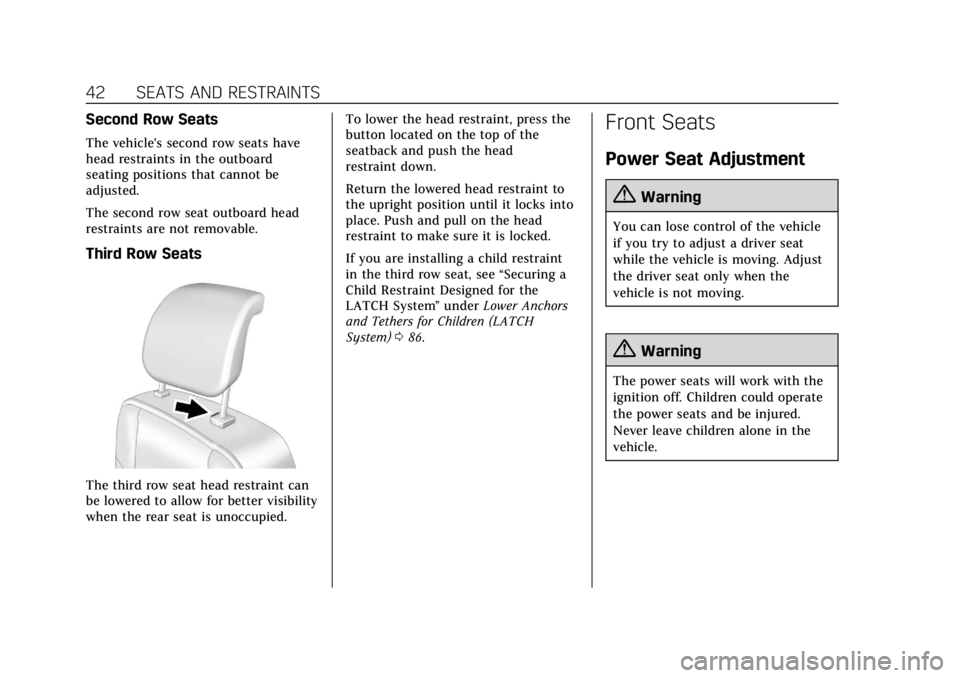
Cadillac Escalade Owner Manual (GMNA-Localizing-U.S./Canada/Mexico-
13566588) - 2020 - CRC - 4/24/19
42 SEATS AND RESTRAINTS
Second Row Seats
The vehicle's second row seats have
head restraints in the outboard
seating positions that cannot be
adjusted.
The second row seat outboard head
restraints are not removable.
Third Row Seats
The third row seat head restraint can
be lowered to allow for better visibility
when the rear seat is unoccupied.To lower the head restraint, press the
button located on the top of the
seatback and push the head
restraint down.
Return the lowered head restraint to
the upright position until it locks into
place. Push and pull on the head
restraint to make sure it is locked.
If you are installing a child restraint
in the third row seat, see
“Securing a
Child Restraint Designed for the
LATCH System ”under Lower Anchors
and Tethers for Children (LATCH
System) 086.
Front Seats
Power Seat Adjustment
{Warning
You can lose control of the vehicle
if you try to adjust a driver seat
while the vehicle is moving. Adjust
the driver seat only when the
vehicle is not moving.
{Warning
The power seats will work with the
ignition off. Children could operate
the power seats and be injured.
Never leave children alone in the
vehicle.
Page 51 of 392
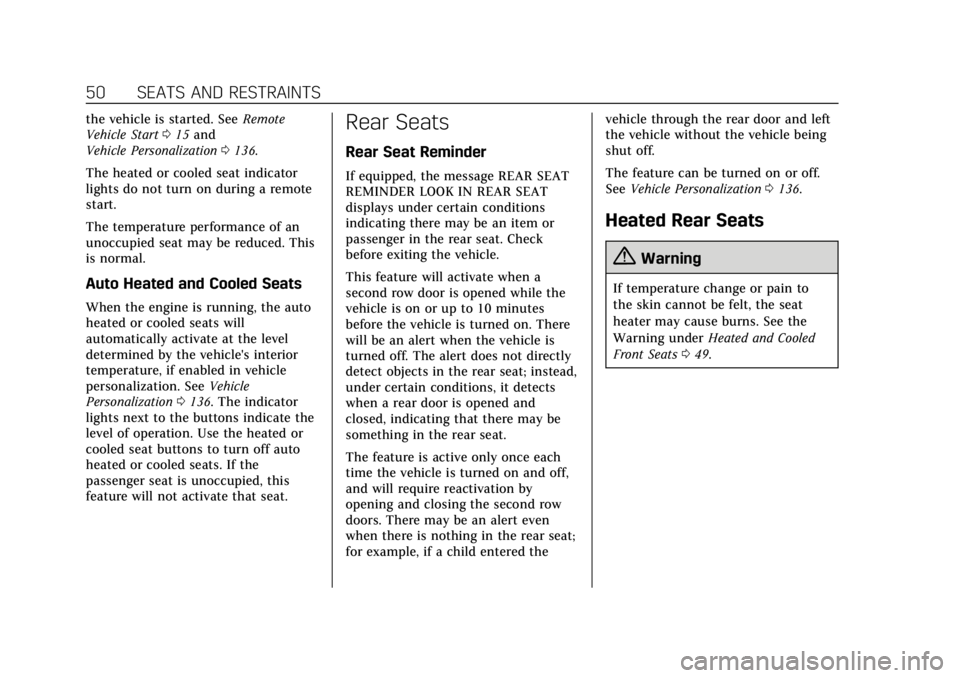
Cadillac Escalade Owner Manual (GMNA-Localizing-U.S./Canada/Mexico-
13566588) - 2020 - CRC - 4/24/19
50 SEATS AND RESTRAINTS
the vehicle is started. SeeRemote
Vehicle Start 015 and
Vehicle Personalization 0136.
The heated or cooled seat indicator
lights do not turn on during a remote
start.
The temperature performance of an
unoccupied seat may be reduced. This
is normal.
Auto Heated and Cooled Seats
When the engine is running, the auto
heated or cooled seats will
automatically activate at the level
determined by the vehicle's interior
temperature, if enabled in vehicle
personalization. See Vehicle
Personalization 0136. The indicator
lights next to the buttons indicate the
level of operation. Use the heated or
cooled seat buttons to turn off auto
heated or cooled seats. If the
passenger seat is unoccupied, this
feature will not activate that seat.
Rear Seats
Rear Seat Reminder
If equipped, the message REAR SEAT
REMINDER LOOK IN REAR SEAT
displays under certain conditions
indicating there may be an item or
passenger in the rear seat. Check
before exiting the vehicle.
This feature will activate when a
second row door is opened while the
vehicle is on or up to 10 minutes
before the vehicle is turned on. There
will be an alert when the vehicle is
turned off. The alert does not directly
detect objects in the rear seat; instead,
under certain conditions, it detects
when a rear door is opened and
closed, indicating that there may be
something in the rear seat.
The feature is active only once each
time the vehicle is turned on and off,
and will require reactivation by
opening and closing the second row
doors. There may be an alert even
when there is nothing in the rear seat;
for example, if a child entered the vehicle through the rear door and left
the vehicle without the vehicle being
shut off.
The feature can be turned on or off.
See
Vehicle Personalization 0136.
Heated Rear Seats
{Warning
If temperature change or pain to
the skin cannot be felt, the seat
heater may cause burns. See the
Warning under Heated and Cooled
Front Seats 049.
Page 59 of 392
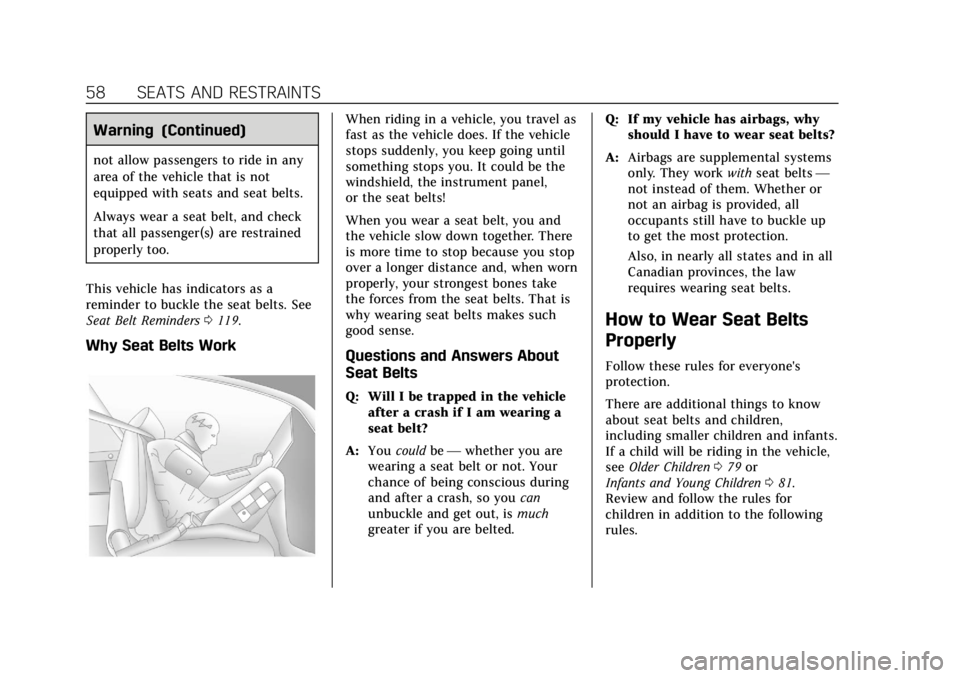
Cadillac Escalade Owner Manual (GMNA-Localizing-U.S./Canada/Mexico-
13566588) - 2020 - CRC - 4/24/19
58 SEATS AND RESTRAINTS
Warning (Continued)
not allow passengers to ride in any
area of the vehicle that is not
equipped with seats and seat belts.
Always wear a seat belt, and check
that all passenger(s) are restrained
properly too.
This vehicle has indicators as a
reminder to buckle the seat belts. See
Seat Belt Reminders 0119.
Why Seat Belts Work
When riding in a vehicle, you travel as
fast as the vehicle does. If the vehicle
stops suddenly, you keep going until
something stops you. It could be the
windshield, the instrument panel,
or the seat belts!
When you wear a seat belt, you and
the vehicle slow down together. There
is more time to stop because you stop
over a longer distance and, when worn
properly, your strongest bones take
the forces from the seat belts. That is
why wearing seat belts makes such
good sense.
Questions and Answers About
Seat Belts
Q: Will I be trapped in the vehicle
after a crash if I am wearing a
seat belt?
A: You could be— whether you are
wearing a seat belt or not. Your
chance of being conscious during
and after a crash, so you can
unbuckle and get out, is much
greater if you are belted. Q: If my vehicle has airbags, why
should I have to wear seat belts?
A: Airbags are supplemental systems
only. They work withseat belts —
not instead of them. Whether or
not an airbag is provided, all
occupants still have to buckle up
to get the most protection.
Also, in nearly all states and in all
Canadian provinces, the law
requires wearing seat belts.
How to Wear Seat Belts
Properly
Follow these rules for everyone's
protection.
There are additional things to know
about seat belts and children,
including smaller children and infants.
If a child will be riding in the vehicle,
see Older Children 079 or
Infants and Young Children 081.
Review and follow the rules for
children in addition to the following
rules.
Page 62 of 392

Cadillac Escalade Owner Manual (GMNA-Localizing-U.S./Canada/Mexico-
13566588) - 2020 - CRC - 4/24/19
SEATS AND RESTRAINTS 61
1. Adjust the seat, if the seat isadjustable, so you can sit up
straight. To see how, see “Seats”
in the Index.
2. Pick up the latch plate and pull the belt across you. Do not let it
get twisted.
The lap-shoulder belt may lock if
you pull the belt across you very
quickly. If this happens, let the
belt go back slightly to unlock it.
Then pull the belt across you
more slowly.
If the shoulder portion of a
passenger belt is pulled out all
the way, the child restraint locking feature may be engaged.
See
Child Restraint Systems 083.
If this occurs, let the belt go back
all the way and start again. If the
locking feature stays engaged
after letting the belt go back to
stowed position on the seat,
move the seat rearward or recline
the seat until the shoulder belt
retractor lock releases.
Engaging the child restraint
locking feature in the front
outboard seating position may
affect the passenger sensing
system. See Passenger Sensing
System 073.
For front seating positions, if the
webbing locks in the latch plate
before it reaches the buckle, tilt
the latch plate flat to unlock.
3. Push the latch plate into the
buckle until it clicks. If the latch
plate will not go fully into the
buckle, check if the correct
buckle is being used.
Pull up on the latch plate to
make sure it is secure. If the belt
is not long enough, see Seat Belt
Extender 066.
Page 65 of 392
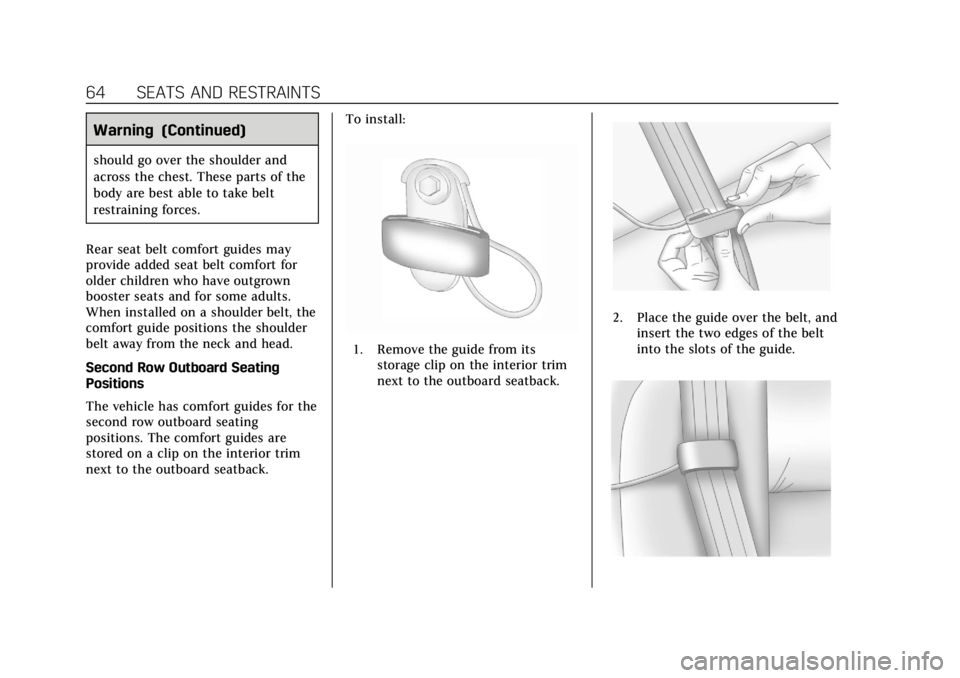
Cadillac Escalade Owner Manual (GMNA-Localizing-U.S./Canada/Mexico-
13566588) - 2020 - CRC - 4/24/19
64 SEATS AND RESTRAINTS
Warning (Continued)
should go over the shoulder and
across the chest. These parts of the
body are best able to take belt
restraining forces.
Rear seat belt comfort guides may
provide added seat belt comfort for
older children who have outgrown
booster seats and for some adults.
When installed on a shoulder belt, the
comfort guide positions the shoulder
belt away from the neck and head.
Second Row Outboard Seating
Positions
The vehicle has comfort guides for the
second row outboard seating
positions. The comfort guides are
stored on a clip on the interior trim
next to the outboard seatback. To install:
1. Remove the guide from its
storage clip on the interior trim
next to the outboard seatback.
2. Place the guide over the belt, andinsert the two edges of the belt
into the slots of the guide.
Page 67 of 392
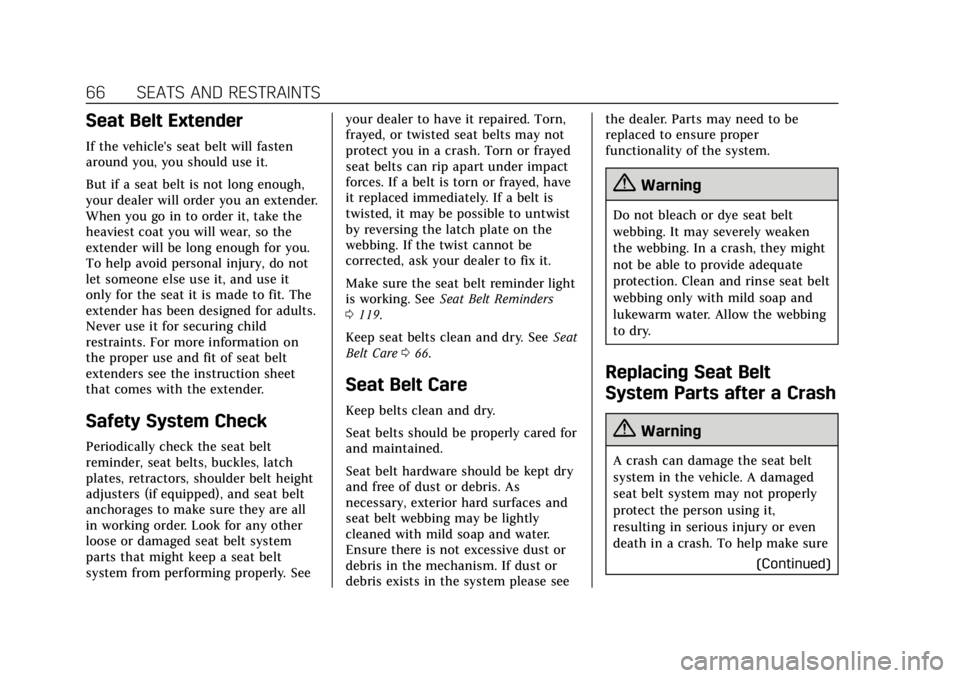
Cadillac Escalade Owner Manual (GMNA-Localizing-U.S./Canada/Mexico-
13566588) - 2020 - CRC - 4/24/19
66 SEATS AND RESTRAINTS
Seat Belt Extender
If the vehicle's seat belt will fasten
around you, you should use it.
But if a seat belt is not long enough,
your dealer will order you an extender.
When you go in to order it, take the
heaviest coat you will wear, so the
extender will be long enough for you.
To help avoid personal injury, do not
let someone else use it, and use it
only for the seat it is made to fit. The
extender has been designed for adults.
Never use it for securing child
restraints. For more information on
the proper use and fit of seat belt
extenders see the instruction sheet
that comes with the extender.
Safety System Check
Periodically check the seat belt
reminder, seat belts, buckles, latch
plates, retractors, shoulder belt height
adjusters (if equipped), and seat belt
anchorages to make sure they are all
in working order. Look for any other
loose or damaged seat belt system
parts that might keep a seat belt
system from performing properly. Seeyour dealer to have it repaired. Torn,
frayed, or twisted seat belts may not
protect you in a crash. Torn or frayed
seat belts can rip apart under impact
forces. If a belt is torn or frayed, have
it replaced immediately. If a belt is
twisted, it may be possible to untwist
by reversing the latch plate on the
webbing. If the twist cannot be
corrected, ask your dealer to fix it.
Make sure the seat belt reminder light
is working. See
Seat Belt Reminders
0 119.
Keep seat belts clean and dry. See Seat
Belt Care 066.
Seat Belt Care
Keep belts clean and dry.
Seat belts should be properly cared for
and maintained.
Seat belt hardware should be kept dry
and free of dust or debris. As
necessary, exterior hard surfaces and
seat belt webbing may be lightly
cleaned with mild soap and water.
Ensure there is not excessive dust or
debris in the mechanism. If dust or
debris exists in the system please see the dealer. Parts may need to be
replaced to ensure proper
functionality of the system.
{Warning
Do not bleach or dye seat belt
webbing. It may severely weaken
the webbing. In a crash, they might
not be able to provide adequate
protection. Clean and rinse seat belt
webbing only with mild soap and
lukewarm water. Allow the webbing
to dry.
Replacing Seat Belt
System Parts after a Crash
{Warning
A crash can damage the seat belt
system in the vehicle. A damaged
seat belt system may not properly
protect the person using it,
resulting in serious injury or even
death in a crash. To help make sure
(Continued)
Page 69 of 392
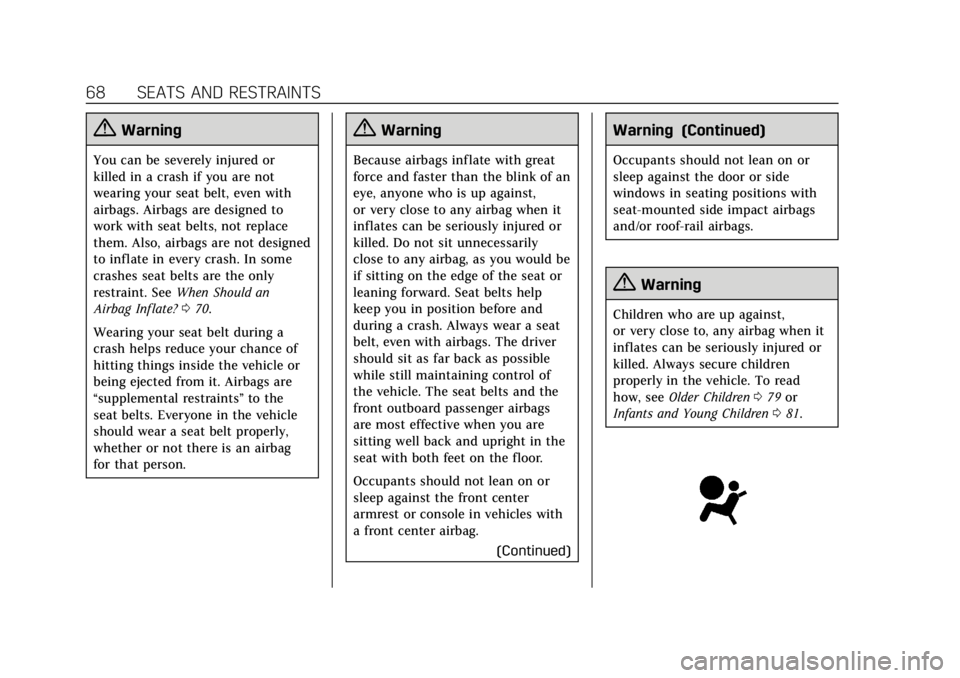
Cadillac Escalade Owner Manual (GMNA-Localizing-U.S./Canada/Mexico-
13566588) - 2020 - CRC - 4/24/19
68 SEATS AND RESTRAINTS
{Warning
You can be severely injured or
killed in a crash if you are not
wearing your seat belt, even with
airbags. Airbags are designed to
work with seat belts, not replace
them. Also, airbags are not designed
to inflate in every crash. In some
crashes seat belts are the only
restraint. SeeWhen Should an
Airbag Inflate? 070.
Wearing your seat belt during a
crash helps reduce your chance of
hitting things inside the vehicle or
being ejected from it. Airbags are
“supplemental restraints” to the
seat belts. Everyone in the vehicle
should wear a seat belt properly,
whether or not there is an airbag
for that person.
{Warning
Because airbags inflate with great
force and faster than the blink of an
eye, anyone who is up against,
or very close to any airbag when it
inflates can be seriously injured or
killed. Do not sit unnecessarily
close to any airbag, as you would be
if sitting on the edge of the seat or
leaning forward. Seat belts help
keep you in position before and
during a crash. Always wear a seat
belt, even with airbags. The driver
should sit as far back as possible
while still maintaining control of
the vehicle. The seat belts and the
front outboard passenger airbags
are most effective when you are
sitting well back and upright in the
seat with both feet on the floor.
Occupants should not lean on or
sleep against the front center
armrest or console in vehicles with
a front center airbag.
(Continued)
Warning (Continued)
Occupants should not lean on or
sleep against the door or side
windows in seating positions with
seat-mounted side impact airbags
and/or roof-rail airbags.
{Warning
Children who are up against,
or very close to, any airbag when it
inflates can be seriously injured or
killed. Always secure children
properly in the vehicle. To read
how, seeOlder Children 079 or
Infants and Young Children 081.
Page 75 of 392
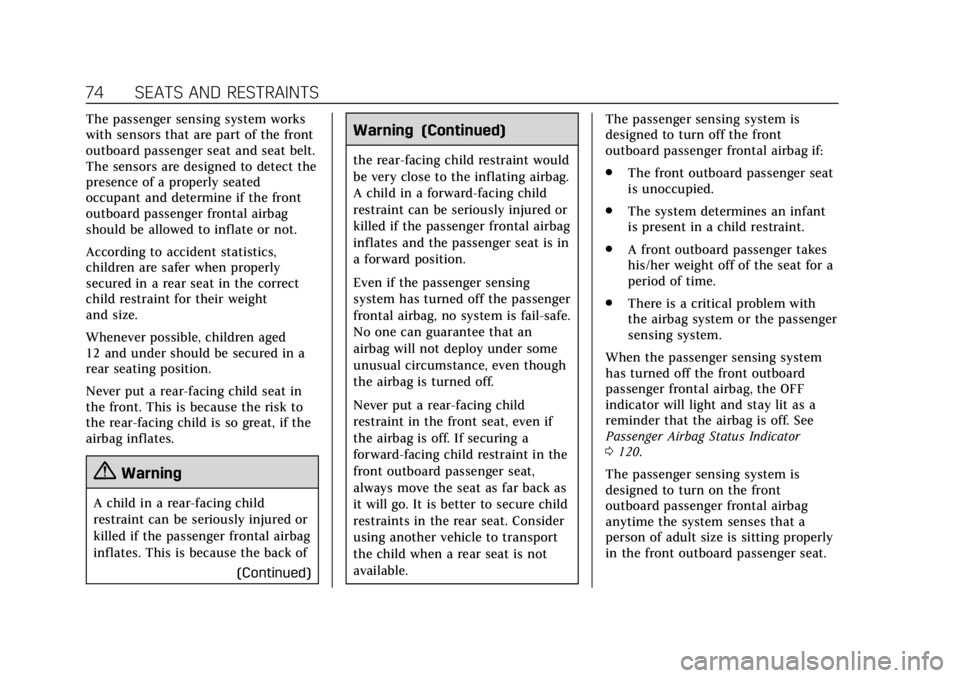
Cadillac Escalade Owner Manual (GMNA-Localizing-U.S./Canada/Mexico-
13566588) - 2020 - CRC - 4/24/19
74 SEATS AND RESTRAINTS
The passenger sensing system works
with sensors that are part of the front
outboard passenger seat and seat belt.
The sensors are designed to detect the
presence of a properly seated
occupant and determine if the front
outboard passenger frontal airbag
should be allowed to inflate or not.
According to accident statistics,
children are safer when properly
secured in a rear seat in the correct
child restraint for their weight
and size.
Whenever possible, children aged
12 and under should be secured in a
rear seating position.
Never put a rear-facing child seat in
the front. This is because the risk to
the rear-facing child is so great, if the
airbag inflates.
{Warning
A child in a rear-facing child
restraint can be seriously injured or
killed if the passenger frontal airbag
inflates. This is because the back of(Continued)
Warning (Continued)
the rear-facing child restraint would
be very close to the inflating airbag.
A child in a forward-facing child
restraint can be seriously injured or
killed if the passenger frontal airbag
inflates and the passenger seat is in
a forward position.
Even if the passenger sensing
system has turned off the passenger
frontal airbag, no system is fail-safe.
No one can guarantee that an
airbag will not deploy under some
unusual circumstance, even though
the airbag is turned off.
Never put a rear-facing child
restraint in the front seat, even if
the airbag is off. If securing a
forward-facing child restraint in the
front outboard passenger seat,
always move the seat as far back as
it will go. It is better to secure child
restraints in the rear seat. Consider
using another vehicle to transport
the child when a rear seat is not
available. The passenger sensing system is
designed to turn off the front
outboard passenger frontal airbag if:
.
The front outboard passenger seat
is unoccupied.
. The system determines an infant
is present in a child restraint.
. A front outboard passenger takes
his/her weight off of the seat for a
period of time.
. There is a critical problem with
the airbag system or the passenger
sensing system.
When the passenger sensing system
has turned off the front outboard
passenger frontal airbag, the OFF
indicator will light and stay lit as a
reminder that the airbag is off. See
Passenger Airbag Status Indicator
0 120.
The passenger sensing system is
designed to turn on the front
outboard passenger frontal airbag
anytime the system senses that a
person of adult size is sitting properly
in the front outboard passenger seat.